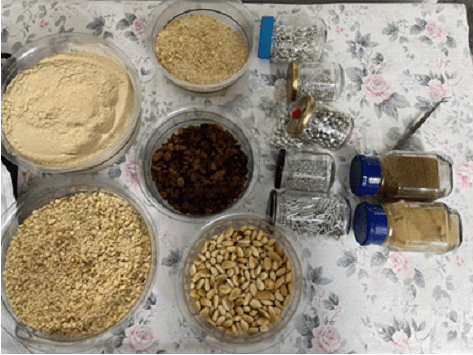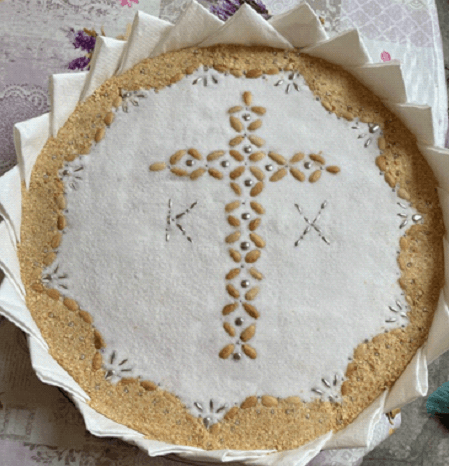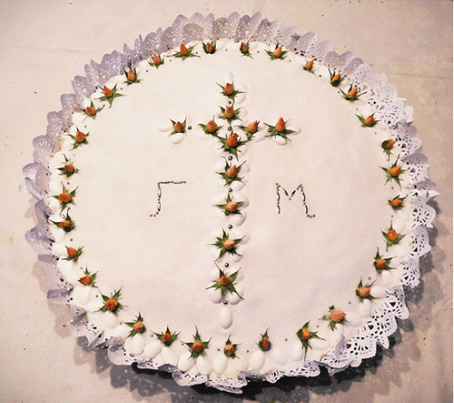Kolliva are boiled wheat, a symbol of the human body, because the human body feeds and grows on it. We take them to the Church at the funeral of the deceased, at memorial days, but also on Psyhoshavvato, Saturday that is dedicated to dead people, giving in that way a special symbolism. The wheat, symbolizes death, burial and resurrection of the bodies. Wheat is the basic element for making Kolliva, but other ingredients vary from place to place and they also have their importance. They say that the ingredients should be 9, as many as the ranks of the Angels and each one has a distinct symbolism.
⦁ Wheat is the symbol of the earth and symbolizes the soul of the dead.
⦁ Pomegranate: with it Addis the god of underground world kept Persephone, while Christians with pomegranate symbolize the splendor of heaven.
⦁ The white almonds or walnuts: they symbolize the bare bones to remind us of the fate we will all have.
⦁ Spices such as cinnamon, cloves, cumin are the flavors of this world.
⦁ Parsley and in some variations mint or marjoram is the wish for rest “in a flourishing place”.
⦁ Nuts, such as walnut, sesame, almonds are the life that reproduces and eternity
⦁ The grit from the strangles or the breadcrumbs or the flour symbolizes the light soil that now covers the dead body.
⦁ Raisins from ancient times symbolize Dionysus and the sweetness of life and for the Orthodox community symbolizes Jesus who is the true vine!
⦁ Sugar symbolizes the sweet paradise, while its whiteness symbolizes the color of triumph and the “infinite light” against the darkness of death.
(Κουρακλής, 2020).
Recipe and implementation
Put the wheat in a bowl and cover it with plenty of cold water. The longer the wheat soaks, the less boiling it needs. Next day, drain it, put it in a pot and cover it with clean water. Bring it to a boil over medium heat for about 15 minutes, until the wheat softens, but does not open and burst. It should be a whole grain, pleasant to chew but not melted. Leave it in a colander to drain well. Put a clean large towel on the counter and spread the wheat on it to dry very well. Leave it for three to four hours so that it dries completely and has no moisture. Preheat the oven to 200 degrees in the air and in a shallow wide baking pan, add the sesame seeds and in another add the flour. Place them in the oven and brown them for about 15 minutes. During baking, stir the sesame seeds and flour with a spoon so that they brown and toast evenly. Remove from the oven and let them cool on the kitchen counter. Grind the sesame seeds in a blender or crush them in a mortar and pestle. In a large bowl, add all the ingredients except the sugar and mix very well. Then on a large flat baking tray put the mixed ingredients. Family and friends are making with their hands 3 times the shape of the cross as they add the mixed wheat. Anyone who wants to honor the deceased in this way participates in the process. In the end, a semi-circular shape filled with all the ingredients is formed and the surface is made smooth by coating the white sugar. At this point, a lady, traditionally, with skills and delicate movements, decorates the tray with several shapes, colored breadcrumbs, silver or white confections and often with flowers. In the centre is the shape of a cross and the initials of the name of the deceased are placed elaborately (Μπαρμπαρίγου, χ.η.)
Kolliva are boiled wheat, a symbol of the human body, because the human body feeds and grows on it. We take them to the Church at the funeral of the deceased, at memorial days, but also on Psyhoshavvato, Saturday that is dedicated to dead people, giving in that way a special symbolism. The wheat, symbolizes death, burial and resurrection of the bodies. Wheat is the basic element for making Kolliva, but other ingredients vary from place to place and they also have their importance. They say that the ingredients should be 9, as many as the ranks of the Angels and each one has a distinct symbolism.
⦁ Wheat is the symbol of the earth and symbolizes the soul of the dead.
⦁ Pomegranate: with it Addis the god of underground world kept Persephone, while Christians with pomegranate symbolize the splendor of heaven.
⦁ The white almonds or walnuts: they symbolize the bare bones to remind us of the fate we will all have.
⦁ Spices such as cinnamon, cloves, cumin are the flavors of this world.
⦁ Parsley and in some variations mint or marjoram is the wish for rest “in a flourishing place”.
⦁ Nuts, such as walnut, sesame, almonds are the life that reproduces and eternity
⦁ The grit from the strangles or the breadcrumbs or the flour symbolizes the light soil that now covers the dead body.
⦁ Raisins from ancient times symbolize Dionysus and the sweetness of life and for the Orthodox community symbolizes Jesus who is the true vine!
⦁ Sugar symbolizes the sweet paradise, while its whiteness symbolizes the color of triumph and the “infinite light” against the darkness of death.
(Κουρακλής, 2020).
Recipe and implementation
Put the wheat in a bowl and cover it with plenty of cold water. The longer the wheat soaks, the less boiling it needs. Next day, drain it, put it in a pot and cover it with clean water. Bring it to a boil over medium heat for about 15 minutes, until the wheat softens, but does not open and burst. It should be a whole grain, pleasant to chew but not melted. Leave it in a colander to drain well. Put a clean large towel on the counter and spread the wheat on it to dry very well. Leave it for three to four hours so that it dries completely and has no moisture. Preheat the oven to 200 degrees in the air and in a shallow wide baking pan, add the sesame seeds and in another add the flour. Place them in the oven and brown them for about 15 minutes. During baking, stir the sesame seeds and flour with a spoon so that they brown and toast evenly. Remove from the oven and let them cool on the kitchen counter. Grind the sesame seeds in a blender or crush them in a mortar and pestle. In a large bowl, add all the ingredients except the sugar and mix very well. Then on a large flat baking tray put the mixed ingredients. Family and friends are making with their hands 3 times the shape of the cross as they add the mixed wheat. Anyone who wants to honor the deceased in this way participates in the process. In the end, a semi-circular shape filled with all the ingredients is formed and the surface is made smooth by coating the white sugar. At this point, a lady, traditionally, with skills and delicate movements, decorates the tray with several shapes, colored breadcrumbs, silver or white confections and often with flowers. In the centre is the shape of a cross and the initials of the name of the deceased are placed elaborately (Μπαρμπαρίγου, χ.η.)


Photos by Michailidis Kyriakos and Chatzisavva Kiki
Bibliography
Κουρακλής Π. (2020). Κόλλυβα, μια προσφορά μνήμης και αγάπης. Retrieved November 18, 2022 from
http://votaniki.gr/farmaka-kai-ypertrofes/kollyva-mia-prosfora-mnimis-kai-agapis/
Μπαρμπαρίγου, Α. (χ.η.). Κόλλυβα Συνταγή. Retrieved November 18, 2022 from
https://www.argiro.gr/recipe/kolluba-syntagi/

